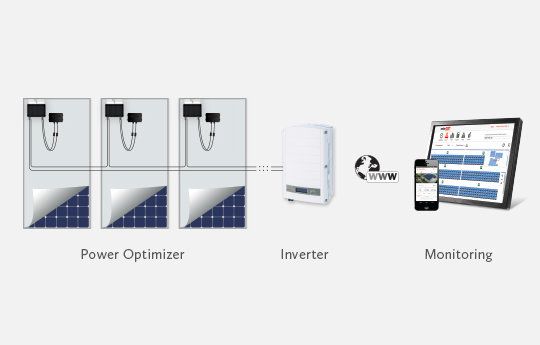
SolarEdge is an Israeli-based company offering PV solar inverters.
Currently providing almost 90 percent of all residential power inverter needs, SolarEdge has quite the edge in the solar market.
What makes SolarEdge unique is their combined power optimizer and string inverter systems are a best-of-both-worlds solution between string inverters and microinverters.
A Brief Rundown on Solar Inverters
String inverters have traditionally been the standard in the solar industry. They send the power produced by solar panels to a central inverter that changes it from DC to usable AC power for your home.
Microinverters, on the other hand, convert DC to AC power at each individual panel and allow for monitoring and power regulation at the panel level. This is useful for homes that are located somewhere with shading from clouds, trees, or other buildings.
Read more on the differences between string inverters and microinverters here. Or watch the animated short below.
The SolarEdge Difference – Optimizers!
SolarEdge power optimizers are somewhere in between string and micros…
They allow panel-level monitoring and power regulation as with a microinverter, but the actual inversion from DC to AC still occurs at a central SolarEdge string inverter.
This is accomplished with SolarEdge power optimizers attached to each panel, as pictured below.

SolarEdge Inverter Efficiency
While efficiency standards for residential inverters are generally 95 to 98 percent, SolarEdge inverter plus power optimizers boast a maximum efficiency of 99.5 percent.
Here’s why SolarEdge inverters are so effective:
- They are more efficient than normal string inverters because they avoid loss of power caused by individual panel shading or malfunctioning.
- They are more effective than microinverters for larger systems because they are not limited by the cap of 21 microinverter panels, due to voltage regulations.
If panels are shaded, SolarEdge power optimizers reconfigure their output so that the combined voltage is roughly 350 volts. The end result is that an output drop in one or more panels does not impact the overall effectiveness of the others.
This is a huge advantage for power optimizers in general, and SolarEdge, in particular, leads the market here.
SolarEdge Power Optimized String Inverter Performance
Overall, Solar.com customers to report good experiences with SolarEdge inverters. Some reasons they list for their support are:
- Inverters work well and are very quiet
- Easy-to-use and thorough monitoring system
- Mitigated shading or multiple angle issues
- Optional battery connectivity for self-consumption and/or backup
- Incredible reliability of hardware
- Higher system output and module-level data logging
Value and Warranty of SolarEdge Inverters
The biggest value proposition of SolarEdge inverters is that they offer the benefits of both string and microinverters at the same time, at a price point between the two.
Systems are also completely expandable. Homeowners can add another array much more easily in the future if energy needs increase. This is a more difficult process with a traditional string inverter, which may require a second central inverter installation. And it’s less expensive than adding more panels with built-in microinverters.
The SolarEdge inverter itself has a 12-year warranty, and their optimizers have a 25-year warranty. There is also an inexpensive option to extend the inverter warranty to 25 years as well. Both warranties are on the higher end of industry standards, which typically fall between 5 and 12 years on average.
If you decide you like the idea of SolarEdge’s optimizers but want to go with another inverter brand, you can do that. SolarEdge built independent operation technology into their optimizers, so they can be used with most any other inverter.
SolarEdge Temperature Coefficient and Safety Features
Inverters function at full capacity when the surrounding air is cooler. When the ambient temperature is too warm, SolarEdge inverters reduce the current output to protect the equipment and prolong its life. It’s also a safety feature so that your system isn’t overloaded.
Another safety feature is SolarEdge SafeDC™ which automatically turns off your solar panels in case of a grid outage. This prevents a voltage surge, electrocution, or damage to your home. SolarEdge inverters are also battery-ready and fully integrated with Tesla’s Powerwall.
SolarEdge – The Top Inverter on Solar.com
All-in-all SolarEdge offers high-efficiency power optimizers and inverters at a competitive price. They also offer great design flexibility, fewer moving parts, comprehensive system monitoring, and industry-leading warranties. Not surprisingly, SolarEdge was the number one selected inverter through the Solar.com platform in 2017.
If you’re looking into a new home solar panel system, here’s a few things to keep in mind:
- Be sure you’re choosing a qualified installer who’s familiar with all of the equipment and financing options available to you.
- In terms of paying for the system, ownership through a cash purchase or loan will produce the best savings. Leases are another great option if you can’t take advantage of the 30% federal solar tax credit.
- Use solar quote comparing platforms like Solar.com to easily see what the best installers in your area offer. They’ll compete online for your business, without you needing to hassle with negotiating.
Do you have a SolarEdge Power Optimized String Inverter? Let us know about your experience with it in the comments below.






